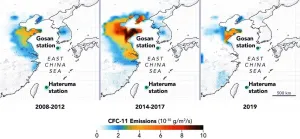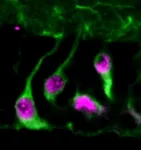Emissions of banned ozone-depleting substance back on decline
International team to tackle atmospheric pollution
2021-02-11
(Press-News.org) Two international studies of a consortium including more than a dozen institutions the world over, including Empa, published today in the journal Nature show levels of CFC-11 emissions, one of many chlorofluorocarbon (CFC) chemicals once widely used in refrigerators and insulating foams, are back on the decline - less than two years after their shock resurgence in the wake of suspected rogue production in eastern China was widely publicized.
"The findings are very welcome news and hopefully mark an end to a disturbing period of apparent regulatory breaches", says Luke Western from the University of Bristol, a co-lead author of one of the studies. "If the emissions had stayed at the significantly elevated levels we found, there could have been a delay, possibly of many years, in ozone layer recovery. On top of that, since CFC-11 is also a potent greenhouse gas, the new emissions were contributing to climate change at levels similar to the CO2 emissions of a megacity."
A mysterious increase
The production of CFC-11 was banned globally in 2010 as part of the Montreal Protocol (see box), a historic international treaty that mandated the phase-out of ozone-depleting substances. Thereafter, CFC-11 emissions should have steadily fallen. In 2018, however, some of the same scientists behind the recent more reassuring discovery found an unexpected jump in emissions had begun around 2013, prompting alarm at the time that production of the banned substance had resumed in an apparent violation of the Montreal Protocol.
The first sign of something untoward was spotted by an international atmospheric monitoring team led by Steve Montzka from the US National Oceanic and Atmospheric Administration (NOAA). The team noticed that since 2013, CFC-11 concentration had declined more slowly than predicted, clearly indicating an upturn in emissions. Their results suggested that some of the increase was from eastern Asia. These unexpected findings were confirmed the following year by an independent global measurement network, the Advanced Global Atmospheric Gases Experiment (AGAGE; see box). Thus, the global data clearly suggested new emissions. The question was where exactly?
The answer lay in the measurements at AGAGE and affiliate monitoring stations that detect polluted air from nearby regions. Using data from Korean and Japanese stations, it appeared around half of the increase in global measurements originated from parts of eastern China. "We estimated that up to around 100'000 metric tons of CFC-11 have been newly incorporated into foams in China in the last seven years. This would correspond to a cargo train of 50 km length filled with the substance", says Stefan Reimann from Empa, the Swiss Federal Laboratories for Materials Science and Technology, a co-author of the 2019 as well as one of the two new studies.
Research results with a punch
Further investigation by media and environmental campaigners exposed usage of CFC-11 in the manufacture of insulating foams in China. Chinese authorities took notice, and at meetings of the Montreal Protocol in 2018 and 2019, they confirmed some banned ozone-depleting substances were identified during factory inspections, but only in very small amounts relative to those inferred from the atmospheric data. According to their reports, arrests, material seizures, and the demolition of production facilities ensued.
The scientific teams have continued to closely monitor atmospheric levels, and the latest evidence, reported in the two new papers in Nature on global CFC-11 emissions and eastern Chinese emissions, indicates that those efforts have resulted in dramatic emission declines. "This new analysis shows the importance of independent validation of international environmental treaties. Without the measurements in this region of the world, it would not have been possible to pin down emissions in this specific region", says Reimann, adding that there are still large parts of the world, which are not covered by similar measurements.
To quantify how emissions have changed at regional scales, the scientists compared the pollution enhancements observed in the Korean and Japanese measurement data to computer models simulating how CFC-11 is transported through the atmosphere. With the global data, they used another type of model that quantified the change in emissions that is required to match the observed global CFC-11 concentration trends.
Back to normal
At both the regional and the global scale, the findings were striking; Emissions had dropped by thousands of tons per year between 2017 and 2019. In fact, the team estimates this recent decline is comparable or even greater than the original increase, which is a remarkable turnaround.
Whilst the findings suggest the rapid action in eastern China and other regions of the world has likely prevented a substantial delay in ozone layer recovery, any unreported production will have a lingering environmental impact. And since the estimated eastern Chinese CFC-11 emissions could not fully account for the inferred global emissions, there are calls to enhance international efforts to track and trace any future emitting regions.
The necessity of independent verification
As a direct result of these findings, the Parties of the Montreal Protocol are now taking steps to identify, locate and quantify any future unexpected emissions of controlled substances by expanding the coverage of atmospheric measurements in key regions of the globe. What applies to CFC-11 also applies to other synthetic gases, as demonstrated by another recent Empa study, published in the journal PNAS. These findings emphasize the need to be on the lookout before new environmental threats develop on a large scale (see box).
What's more, says Empa's Stephan Henne, also a co-author of one of the new studies: "This method of checking for emissions could prove to be very helpful, when in the not-so-distant future several countries will have to dramatically reduce the amount of greenhouse gas emissions because of their commitments to the Paris Agreement." The scientific community is currently working hard on observation and modelling systems that will allow independent emission estimation for the major greenhouse gases on country level, he adds, thereby fostering mutual trust among the signatory countries.
New ozone-destroying chemical detected in the atmosphere
An international team of scientists, led by Empa's Martin Vollmer, has spotted three new ozone-depleting chemicals in the atmosphere, they reported in a recent issue of PNAS. The team analyzed air samples gathered around the world by the AGAGE network of measuring stations. The team found a hydrochlorofluorocarbon compound, HCFC-132b, which had never before been detected in the atmosphere. Looking at archived air samples, HCFC-132b first showed up around 20 years ago. Since then, atmospheric concentrations of the chemical, which seems to be coming from factories in East Asia, have increased steadily. What is mysterious: There is thus far no known practical application for HCFC-132b.
INFORMATION:
[Attachments] See images for this press release:

ELSE PRESS RELEASES FROM THIS DATE:
2021-02-11
Cerebral small vessel disease (SVD) is characterized by damage to the blood vessels and parenchyma in the brain. It presents as a multitude of symptoms, which makes the diagnosis difficult. Matters are complicated further when SVD sets in along with other comorbidities with similar symptoms. Therefore, accurate diagnosis at an early stage of disease progression helps in defining better prognosis and management strategies for patients with cerebral SVD.
A team of researchers from the United Kingdom set out to review more than 10,000 studies on clinical diagnosis, risk factors, progression, and intervention ...
2021-02-11
Experts have spent decades warning us about the rising rates of childhood obesity, which has become an epidemic among recent generations in many places around the world, including Spain. The transition from the traditional Mediterranean diet to the consumption of processed foods with low nutritional value is a key contributor, with child-targeted advertising also partly to blame. According to the Breakfast Food Advertisements in Mediterranean Countries: Products' Sugar Content in Adverts from 2015 to 2019 report produced by UOC Faculty of Information and Communication Sciences professor and researcher, Mireia Montaña, the majority of breakfast products ...
2021-02-11
In recent years, active, self-propelled particles have received growing interest amongst the scientific community. Examples of active particles and their systems are numerous and very diverse, ranging from bacterium films to flocks of birds or human crowds. These systems can demonstrate unusual behavior, which is challenging to understand or model.
To this end, large-scale models of active particles were being scrutinised by experts at Leicester, in order to understand basic principles underlying active particle dynamics and apply them in a scenario of an evacuation strategy for customers in crowded place. Unexpectedly, the 'super-particles' milling in a circular motion were stumbled upon ...
2021-02-11
There's a reason that ideas--even erroneous ones--catch fire on social media or in popular culture: groupthink.
New research co-authored by Berkeley Haas Asst. Prof. Douglas Guilbeault shows that large groups of people all tend to think alike, and also illustrates how easily people's opinions can be swayed by social media--even by artificial users known as bots.
In a series of experiments, published in the journal Nature Communications, Guilbeault and co-authors Damon Centola of the University of Pennsylvania and Andrea Baronchelli of City University London created an online game that asked numerous people to identify ...
2021-02-11
Just as beneficial microbes in the human gut can be affected by antibiotics, diet interventions and other disturbances, the microbiomes of other animals can also be upset. In a rare study published this week, Andrea Jani, a researcher with the University of Hawai'i at Mānoa School of Ocean and Earth Science and Technology (SOEST), determined the skin microbiome of an endangered frog was altered when the frogs were infected by a specific fungus, and it didn't recover to its initial state even when the frog was cured of the infection.
All animals host symbiotic microbes--many ...
2021-02-11
WASHINGTON--Chinese people are more likely to face high blood pressure and other health risks as a result of higher body mass index (BMI) and waist circumference than people from other racial and ethnic groups, according to a new study published in the Endocrine Society's END ...
2021-02-11
SINGAPORE, 10 February 2021 - Researchers studying an enzyme in fruit fly larvae have found that it plays an important role in waking up brain stem cells from their dormant 'quiescent' state, enabling them to proliferate and generate new neurons. Published in the journal EMBO Reports, the study by Duke-NUS Medical School, Singapore, could help clarify how some neurodevelopmental disorders such as autism and microcephaly occur.
Quiescent neural stem cells in the fruit fly larval brainPr-set7 is an enzyme involved in maintaining genome stability, DNA repair and cell cycle regulation, as well as ...
2021-02-11
Modern telecommunication systems rely on satellites to relay signals across the globe quickly and reliably, enabling users to send messages across the world in an instant, watch live television, or - more recently - hold conference calls with global partners right from the kitchen table!
Communications satellites use high-frequency radio waves to transmit data, with antennas acting as a two-way interface, converting electric current provided by the transmitter into radio waves, and vice versa when paired with a receiver. Antennas are therefore vital pieces of equipment, without which satellites and ground receivers would be practically useless. However, despite advances in modern satellite design and performance, antenna technology remains a limiting factor for ...
2021-02-11
With the advent of 5G communication technology and its integration with AI, we are looking at the dawn of a new era in which people, machines, objects, and devices are connected like never before. This smart era will be characterized by smart facilities and services such as self-driving cars, smart UAVs, and intelligent healthcare. This will be the aftermath of a technological revolution.
But the flip side of such technological revolution is that AI itself can be used to attack or threaten the security of 5G-enabled systems which, in turn, can greatly compromise their reliability. It is, therefore, imperative to investigate such potential security threats and explore countermeasures before a smart world is realized.
In a recent study published ...
2021-02-11
Researchers at the University of Virginia School of Medicine have shed light on what causes herpes simplex virus to flare up, explaining how stress, illness and even sunburn can trigger unwanted outbreaks.
The discovery could lead to new ways to prevent cold sores and herpes-related eye disease from reoccurring, the researchers report.
"Herpes simplex recurrence has long been associated with stress, fever and sunburn," said researcher Anna R. Cliffe, PhD, of UVA's Department of Microbiology, Immunology and Cancer Biology. "This study sheds light on how all these triggers can lead to herpes simplex-associated disease."
About Herpes Simplex ...
LAST 30 PRESS RELEASES:
[Press-News.org] Emissions of banned ozone-depleting substance back on decline
International team to tackle atmospheric pollution






